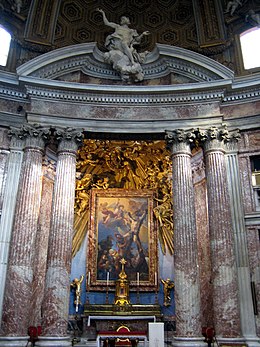
Italian Baroque (or Barocco) is a stylistic period in Italian history and art that spanned from the late 16th century to the early 18th century.

Italian Baroque (or Barocco) is a stylistic period in Italian history and art that spanned from the late 16th century to the early 18th century.
The early 17th century marked a time of change for those of the Roman Catholic religion, a symbolization of their strength as a congregation and the intelligence of their creative minds. In response to the Protestant Reformation of the earlier 16th century, Roman Catholics embarked on a program of restoration, a new way of living that became known as the Counter Reformation. The purpose of the Counter Reformation was aimed at remedying some of the abuses challenged by the Protestants earlier in the century. [1] Within the church, a renewed Catholic culture was imposed on Italian society. It started with the Council of Trent, imposed by Pope Paul III, a commission of cardinals who came together to address issues of the Catholic Church and regain faith among worshipers. [2] This resulted in guidelines established by the Church for the commissioning work of artists to communicate biblical truths and ideals.
New secular construction resulted from the establishment of pioneering religious orders. Between 1524 and 1575, the Barnabite, Jesuit, Oratorian and Theatine orders came into being, and as their influence spread, more and more new churches began being built. By 1725, there were 323 churches in Rome alone, serving a permanent population of fewer than 150,000 people. [1] Because of this rapid growth in church building, it became the responsibility of these religious orders to spread the word of Catholicism to the population. Religious books were increasingly being printed in Venice for distribution to the clergy and literate worshipers, passed out during mass and offering continuous reminders of the presence of Christ on everyday life. [3]
Churches had now become a place for encouragement- spaces of expansive beauty and decoration.
They provided exciting imagery that contrasted greatly with the iconoclastic inclinations of the Protestant Reformation led by Martin Luther”. [2]
The Roman Church realized the power that art could have to inspire and, therefore, they became preoccupied with extravagance and display. Their intent was to overwhelm viewers, catch their attention, and make them want to see more. Entering a Baroque church where visual space, music and ceremony were combined was a powerful device for securing loyalty of congregations. The bigger and more beautiful the space, the more people wanted to go. Complex geometry, curving and intricate stairway arrangements and large-scale sculptural ornamentation offered a sense of movement and mystery within the space.
Il Gesù was the first of many Counter-Reformation churches built in Rome; serving as the mother church of the new Jesuit order. Designed by Giacomo Barozzi da Vignola, the church of Il Gesù soon became the prototype for the Baroque churches that the Jesuit order built or rebuilt during the Counter-Reformation era. [4] The interior of the Gesu was a study of the grandeur that Roman classicism could offer when combined with simplicity in large scale. High windows puncture the nave's barrel vault, as a ring of windows in the drum of the dome bring beams of natural light into the interior, creating a dramatic contrast of light and darkness in relatively dim space. [2]
The plan of Il Gesù became the standard for churches for years to come; a breakaway from the ideal central-plan church of the Renaissance into something new. The Latin Cross variation created a greater sense of spatial unification within the space. In his design for the church of Il Gesù, Vignola broadened the nave and made the transepts and side chapels smaller, creating a better and brighter focal point for the main space and allowing more room for the congregation at mass. [4] The cultural patronage of the pope in Rome was an extreme case of diversity in comparison with surrounding Italian city-states. The pope served his role as not only the head of the Catholic Church, but as the acting ruler for the city. He [the pope] controlled what was built and who was commissioned to build it.
In 1605, at the very beginning of his pontificate, Pope Paul V commissioned Carlo Maderno to redesign St. Peter's Basilica. It was at the age of 72, in 1546, when Michelangelo first took hold of the unfinished rebuilding project started by Bramante. [3] When Michelangelo died, the construction of the, then, Greek-cross section surrounding the Papal altar and the tomb of Peter had been completed only as far as the top of the drum. The dome then became completed, with some modifications, by Giacomo della Porta in 1590. [5] It was the continuous debates over the religious and aesthetic benefits of keeping the Greek-cross plan or enhancing the space by extending it into Latin-cross plan that led Paul V to boldly commission for Maderno's services. Maderno's initial projects, including the long nave addition, which created a new Latin-Cross solution upon the ground plan, the façade and the portico, became an instantly recognizable image of Rome and the heart and spirit of Catholic Christianity. [6]
To solve the problem of excess open space within the updated basilica, Pope Urban VII commissioned Gian Lorenzo Bernini to design the internal space. Bernini became responsible for much of the internal appearance of the basilica, notably the baldacchino (1624–33) erected over the dome of St. Peter. It acts as a main focal point in the space, combining both sculpture and architecture into a unified art piece. Complex in form and ornate with sculpture, the baldacchino serves as a great example of the Baroque ‘style’, massive and ornate, glorifying the church and the Catholic religion.
This space is an example of quadratura, an attempt to create an illusion through architecture, painting, and sculpture. Painting and sculpture create an illusion of never-ending height and dramatic composition.
Pietro da Cortona was one of the painters of the 17th century who employed this illusionist way of painting. Among his most important commissions were the frescoes he painted for the Palace of the Barberini family. Pietro da Cortona's compositions were the largest decorative frescoes executed in Rome since the work of Michelangelo at the Sistine Chapel. [3] Harold Osborne, author of The Oxford Companion of Art, comments on his work the ‘Divine Providence’ completed for the Barberini palace:
This, his most famous painting, is a triumph of illusionism for the centre of the ceiling appears open to the sky and the figures seen from below appear to come down into the room as well as soar out of it”. [2]
Stucco became one of the overall key characteristics of Baroque interiors, enhancing wall spaces, niches, and ceilings.
It was the reverence for the church that provided funding for more and more building projects which, in turn, brought even more worshipers into the city –as many as five times the permanent population during a Holy Year. With this boom in tourism, a continuing job opportunity arose for the citizens of Rome. The construction industry in Rome soon became the largest employer in the city.
Throughout Italy inspiring architects received training on-the-job. In most parts of Italy, local architects satisfied building needs, but in Rome architects were specifically commissioned either by the Papal state or family dynasties to work on their projects. [1] Families associated with the papacy, including the Barberini, Borghese, Chigi and Pamphili, were extremely well off and, in turn, some of the richest and grandest villas were constructed for them. Competition between these ruling families meant they rivaled each other in the elaborateness of the detailing in their homes as well as in the churches they supported. [2]
The hot climate of Italy influenced the choosing of materials and planning of architecture. For flooring, tile, marble and stone were used; terrazzo flooring, created by chips of marble case into cement, was also sometimes used in interiors. All of these materials helped cool the space. Consideration of geographic location was also examined during construction planning. For example, on average, Sicily receives 1,000 more hours of sunshine each year than Turin. [1] The facades in Sicilian-built architecture seem extremely massive in comparison to contemporary ones in the Italian mainland. Regional variations like this can be seen throughout Italy, including Rome.
The role of furniture in Roman interiors was to emphasize social status and to simply add a decorative element to the interior. Carving was the preferred method of decorating furniture; while walnut was the primary furniture wood. [2] Emphasis for furniture was on carved and turned members, which were elaborately placed on high-back armchairs and tables.
Spatial relationships for the interior in the age of the Baroque changed from the block structure of the Renaissance to more open planning. Grand proportions were typical in Baroque interiors. The salone was given high priority, again with an emphasis on exaggerated decoration, this time incorporating accents into the room at different heights. Niches, entablatures, pediments and wall reliefs created dynamics within the space.
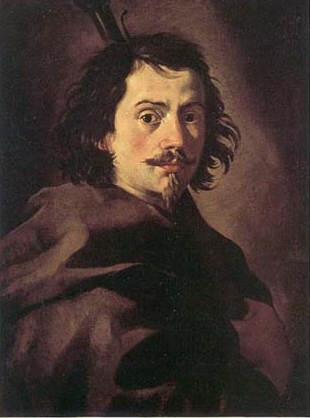
Francesco Borromini, byname of Francesco Castelli, was an Italian architect born in the modern Swiss canton of Ticino who, with his contemporaries Gian Lorenzo Bernini and Pietro da Cortona, was a leading figure in the emergence of Roman Baroque architecture.

Gian LorenzoBernini was an Italian sculptor and architect. While a major figure in the world of architecture, he was more prominently the leading sculptor of his age, credited with creating the Baroque style of sculpture. As one scholar has commented, "What Shakespeare is to drama, Bernini may be to sculpture: the first pan-European sculptor whose name is instantaneously identifiable with a particular manner and vision, and whose influence was inordinately powerful ..." In addition, he was a painter and a man of the theatre: he wrote, directed and acted in plays, for which he designed stage sets and theatrical machinery. He produced designs as well for a wide variety of decorative art objects including lamps, tables, mirrors, and even coaches.

The Papal Basilica of Saint Peter in the Vatican, or simply Saint Peter's Basilica, is a church in the Italian Renaissance style located in Vatican City, an independent microstate enclaved within the city of Rome, Italy. It was initially planned in the 15th century by Pope Nicholas V and then Pope Julius II to replace the aging Old St. Peter's Basilica, which was built in the fourth century by Roman emperor Constantine the Great. Construction of the present basilica began on 18 April 1506 and was completed on 18 November 1626.

Baroque architecture is a highly decorative and theatrical style which appeared in Italy in the early 17th century and gradually spread across Europe. It was originally introduced by the Catholic Church, particularly by the Jesuits, as a means to combat the Reformation and the Protestant church with a new architecture that inspired surprise and awe. It reached its peak in the High Baroque (1625–1675), when it was used in churches and palaces in Italy, Spain, Portugal, France, Bavaria and Austria. In the Late Baroque period (1675–1750), it reached as far as Russia, the Ottoman Empire and the Spanish and Portuguese colonies in Latin America. In about 1730, an even more elaborately decorative variant called Rococo appeared and flourished in Central Europe.

Santa Maria della Vittoria is a Catholic titular church and basilica dedicated to the Virgin Mary in Rome, Italy. The church is known for the masterpiece by Gian Lorenzo Bernini in the Cornaro Chapel, the Ecstasy of Saint Teresa. The church is in the Rione Sallustiano, on number 98 via XX Settembre, where this street intersects with Largo Santa Susanna. It stands to the side of the Fontana dell'Acqua Felice. The church mirrors the Church of Santa Susanna across the Largo. It is about two blocks northwest of the Piazza della Repubblica and Teatro dell'Opera metro station.

The Church of the Gesù is the mother church of the Society of Jesus (Jesuits), a Catholic religious order. Officially named Chiesa del Santissimo Nome di Gesù all'Argentina, its façade is "the first truly baroque façade", introducing the baroque style into architecture. The church served as a model for innumerable Jesuit churches all over the world, especially in the Americas. Its paintings in the nave, crossing, and side chapels became models for Jesuit churches throughout Italy and Europe, as well as those of other orders. The Church of the Gesù is located in the Piazza del Gesù in Rome.

Saint Peter's Square is a large plaza located directly in front of St. Peter's Basilica in Vatican City, the papal enclave in Rome, directly west of the neighborhood (rione) of Borgo. Both the square and the basilica are named after Saint Peter, an apostle of Jesus whom Catholics consider to be the first Pope.

Sant'Andrea della Valle is a minor basilica in the rione of Sant'Eustachio of the city of Rome, Italy. The basilica is the general seat for the religious order of the Theatines. It is located at Piazza Vidoni, at the intersection of Corso Vittorio Emanuele and Corso Rinascimento.

Giovanni Battista Gaulli, also known as Baciccio or Baciccia, was an Italian artist working in the High Baroque and early Rococo periods. He is best known for his grand illusionistic vault frescos in the Church of the Gesù in Rome, Italy. His work was influenced by Gian Lorenzo Bernini.
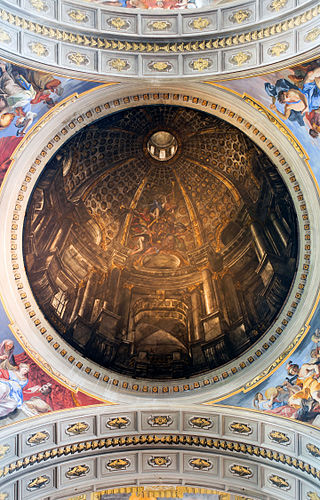
Illusionistic ceiling painting, which includes the techniques of perspective di sotto in sù and quadratura, is the tradition in Renaissance, Baroque and Rococo art in which trompe-l'œil, perspective tools such as foreshortening, and other spatial effects are used to create the illusion of three-dimensional space on an otherwise two-dimensional or mostly flat ceiling surface above the viewer. It is frequently used to create the illusion of an open sky, such as with the oculus in Andrea Mantegna's Camera degli Sposi, or the illusion of an architectural space such as the cupola, one of Andrea Pozzo's frescoes in Sant'Ignazio, Rome. Illusionistic ceiling painting belongs to the general class of illusionism in art, designed to create accurate representations of reality.
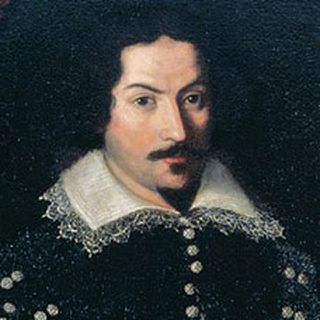
Carlo Maderno (Maderna) was an Italian architect, born in today's Ticino, Switzerland, who is remembered as one of the fathers of Baroque architecture. His façades of Santa Susanna, St. Peter's Basilica and Sant'Andrea della Valle were of key importance in the evolution of the Italian Baroque. He is often referred to as the brother of sculptor Stefano Maderno, but this is not universally agreed upon.

The Palazzo Barberini is a 17th-century palace in Rome, facing the Piazza Barberini in Rione Trevi. Today, it houses the Galleria Nazionale d'Arte Antica, the main national collection of older paintings in Rome.

The church of San Carlo alle Quattro Fontane, also called San Carlino, is a Roman Catholic church in Rome, Italy. The church was designed by the architect Francesco Borromini and it was his first independent commission. It is an iconic masterpiece of Baroque architecture, built as part of a complex of monastic buildings on the Quirinal Hill for the Spanish Trinitarians, an order dedicated to the freeing of Christian slaves. He received the commission in 1634, under the patronage of Cardinal Francesco Barberini, whose palace was across the road. However, this financial backing did not last and subsequently the building project suffered various financial difficulties. It is one of at least three churches in Rome dedicated to San Carlo, including San Carlo ai Catinari and San Carlo al Corso.
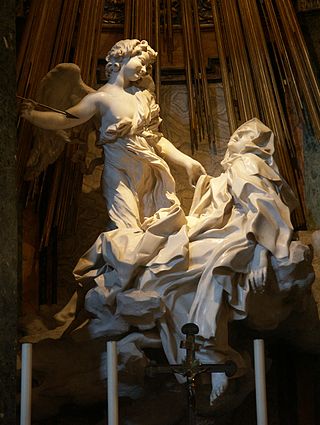
Baroque sculpture is the sculpture associated with the Baroque style of the period between the early 17th and mid 18th centuries. In Baroque sculpture, groups of figures assumed new importance, and there was a dynamic movement and energy of human forms—they spiralled around an empty central vortex, or reached outwards into the surrounding space. Baroque sculpture often had multiple ideal viewing angles, and reflected a general continuation of the Renaissance move away from the relief to sculpture created in the round, and designed to be placed in the middle of a large space—elaborate fountains such as Gian Lorenzo Bernini‘s Fontana dei Quattro Fiumi, or those in the Gardens of Versailles were a Baroque speciality. The Baroque style was perfectly suited to sculpture, with Bernini the dominating figure of the age in works such as The Ecstasy of St Theresa (1647–1652). Much Baroque sculpture added extra-sculptural elements, for example, concealed lighting, or water fountains, or fused sculpture and architecture to create a transformative experience for the viewer. Artists saw themselves as in the classical tradition, but admired Hellenistic and later Roman sculpture, rather than that of the more "Classical" periods as they are seen today.

St. Peter's Baldachin is a large Baroque sculpted bronze canopy, technically called a ciborium or baldachin, over the high altar of St. Peter's Basilica in Vatican City, the city-state and papal enclave surrounded by Rome, Italy. The baldachin is at the center of the crossing, and directly under the dome of the basilica. Designed by the Italian artist Gian Lorenzo Bernini, it was intended to mark, in a monumental way, the place of Saint Peter's tomb underneath. Under its canopy is the high altar of the basilica. Commissioned by Pope Urban VIII, the work began in 1623 and ended in 1634. The baldachin acts as a visual focus within the basilica; it is itself a very large structure and forms a visual mediation between the enormous scale of the building and the human scale of the people officiating at the religious ceremonies at the papal altar beneath its canopy.

Italian Baroque art is a term that is used here to refer to Italian painting and sculpture in the Baroque manner executed over a period that extended from the late sixteenth to the mid eighteenth centuries. Italian Baroque architecture is not covered.

Italian Baroque architecture refers to Baroque architecture in Italy.
Italian Baroque interior design refers to high-style furnishing and interior decorating carried out in Italy during the Baroque period, which lasted from the early 17th to the mid-18th century. In provincial areas, Baroque forms such as the clothes-press or armadio continued to be used into the 19th century.
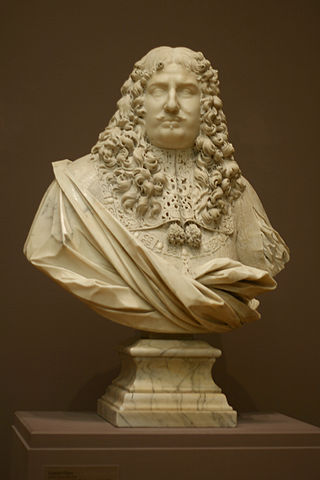
Lorenzo Ottoni, also known as Lorenzo Ottone or Lorenzone, (1658–1736) was an Italian sculptor who was commissioned by the papacy and various noble houses of Renaissance Italy.
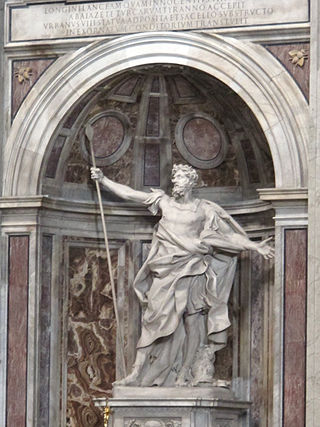
Saint Longinus is a sculpture by the Italian artist Gian Lorenzo Bernini. Completed in 1638, the marble sculpture sits in the north-eastern niche in the crossing of St. Peter's Basilica in Vatican City. It is over four meters high and was commissioned by Pope Urban VIII, a great patron of Bernini.